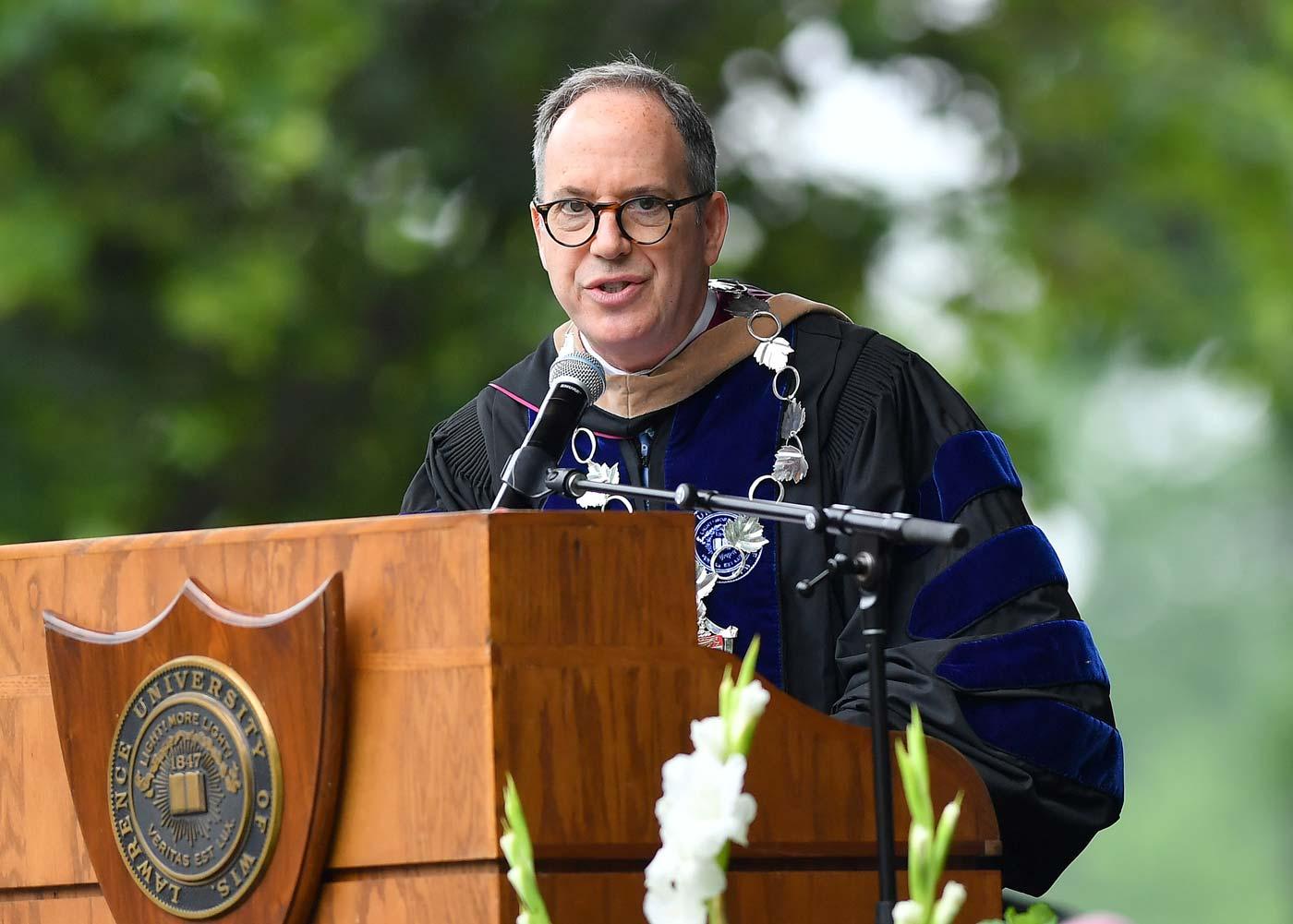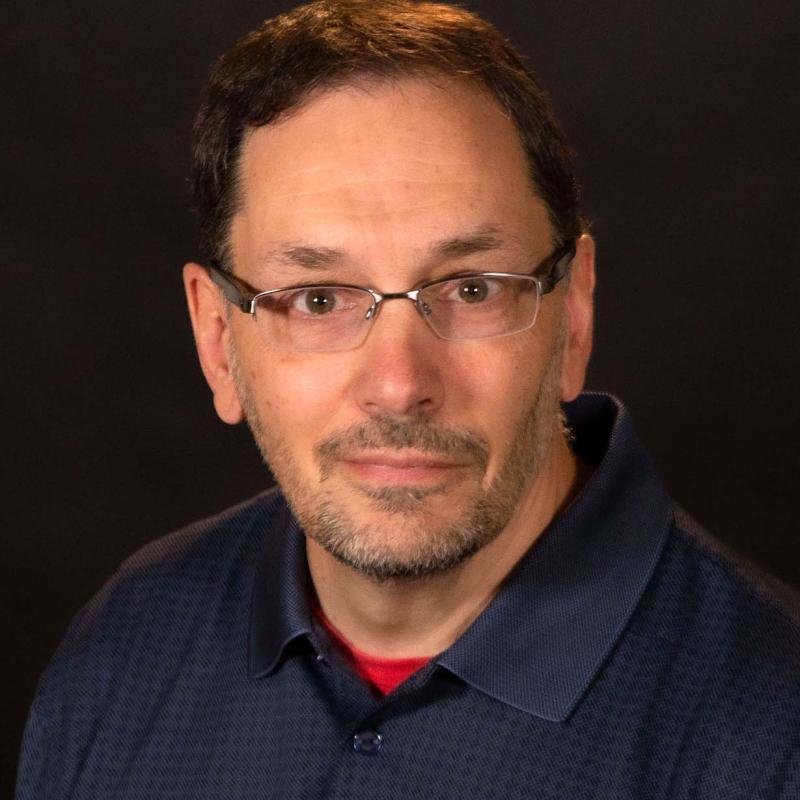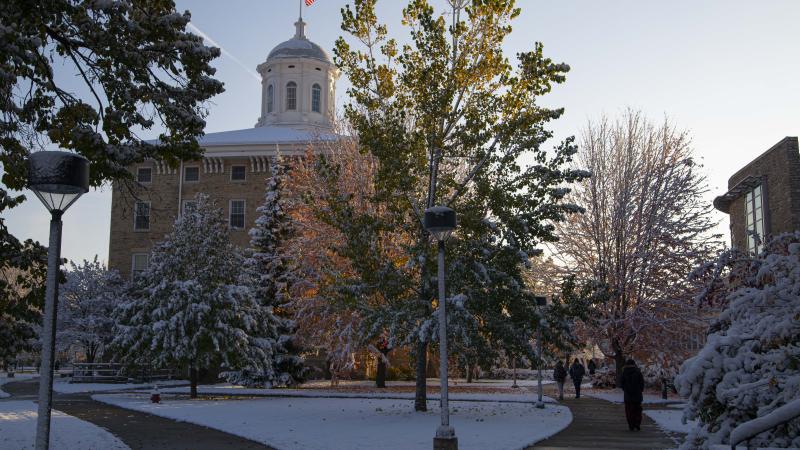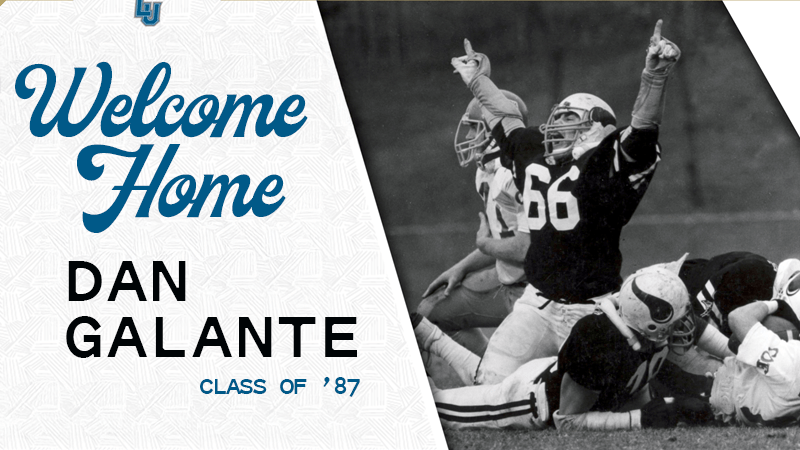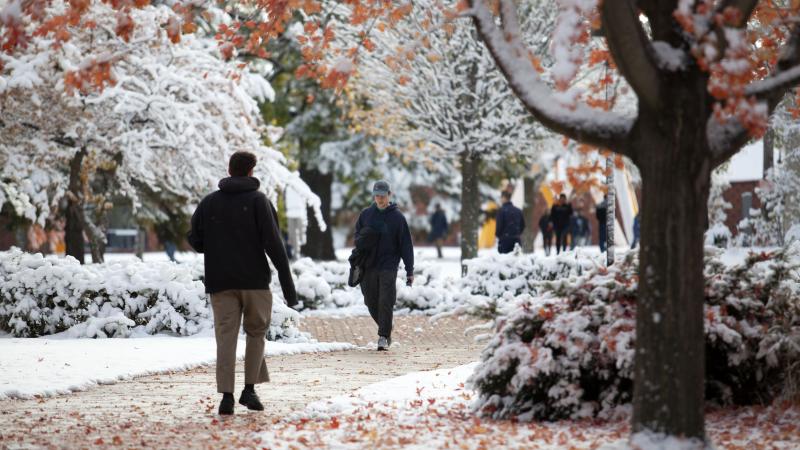Lawrence University’s willingness to adapt, to embrace change without uprooting its deep commitment to the liberal arts, has the school well-positioned to face an onslaught of coming challenges in a tumultuous higher education climate.
The recent close of the Be the Light! Campaign at $232.6 million, well above the $220 million goal, speaks to Lawrence’s strong support among its alumni and friends and its notable reputation as an innovative and supportive liberal arts college. Those are important strengths to lean on at a time when a once-in-a-century pandemic has added to the already sizable hurdles ahead for higher education—rising student debt, closings and mergers, and a shrinking college-age population among them.
The Be the Light! Campaign’s success comes as Lawrence prepares for leadership change. Mark Burstein, the university’s 16th president in its 174-year history, is set to step aside at the close of the academic year. Laurie A. Carter, the newly named 17th president, will begin her tenure on July 1 with those industry challenges front and center, but also with a string of successes to build on—$91 million in investments toward Full Speed to Full Need (FSFN), expanded and strengthened academic programs, a revitalized Career Center, and the refurbishing of facilities across campus.
Those successes, so central to the Burstein presidency and largely made possible by Be the Light!, will provide strength and structure as Lawrence pushes forward amid the headwinds that have dominated and reshaped the higher education conversation.
Lawrence, of course, isn’t immune to the volatility. But the narrative here is different. Lawrence’s endowment is healthy and growing, and its relationship with alumni is robust. The Full Speed to Full Need initiative continues to resonate, lowering student debt and improving accessibility for students of all economic backgrounds. Its enrollment numbers, even amid the pandemic, have remained steady thanks in part to a wider geographic focus. And it has successfully added key in-demand academic programs without sacrificing its liberal arts mission.
That isn’t to say there aren’t choppy waters ahead. For institutions of higher learning that have failed to adapt to changing demographics and the shifting winds of higher education in the 21st century, the results are proving perilous. Lawrence, though, believes it has positioned itself to buck the troubling trends, courtesy of strategic planning years in the making, much of it led by Burstein.
That, perhaps more than anything, will be Burstein’s legacy.
“He has led the university through unprecedented challenges and remarkable opportunities,” said David Blowers, chair of the Board of Trustees. “During Mark’s tenure, our curricular offerings became deeper and broader, applications and the endowment increased dramatically, and our community became more diverse, inclusive, and equity-minded.”
That important work, Burstein said, is and always will be a team effort.
“Thanks to extraordinary faculty, administrative, and volunteer leadership, Lawrence has been able to swim upstream in a very challenging environment for colleges and universities,” he said.
Today, we’ll explore the pressures that are tied to student debt concerns, financial strains that are proving difficult for a growing number of institutions of higher education, the realities of changing demographics that will dramatically reduce the number of high school graduates entering college over the coming decade, and the questioning in some sectors of the importance of a liberal arts education. And we’ll look at how and why Lawrence, despite the pandemic, has put itself in a position to confidently steer its way through those troublesome waters to serve not only current students but future Lawrentians as well.
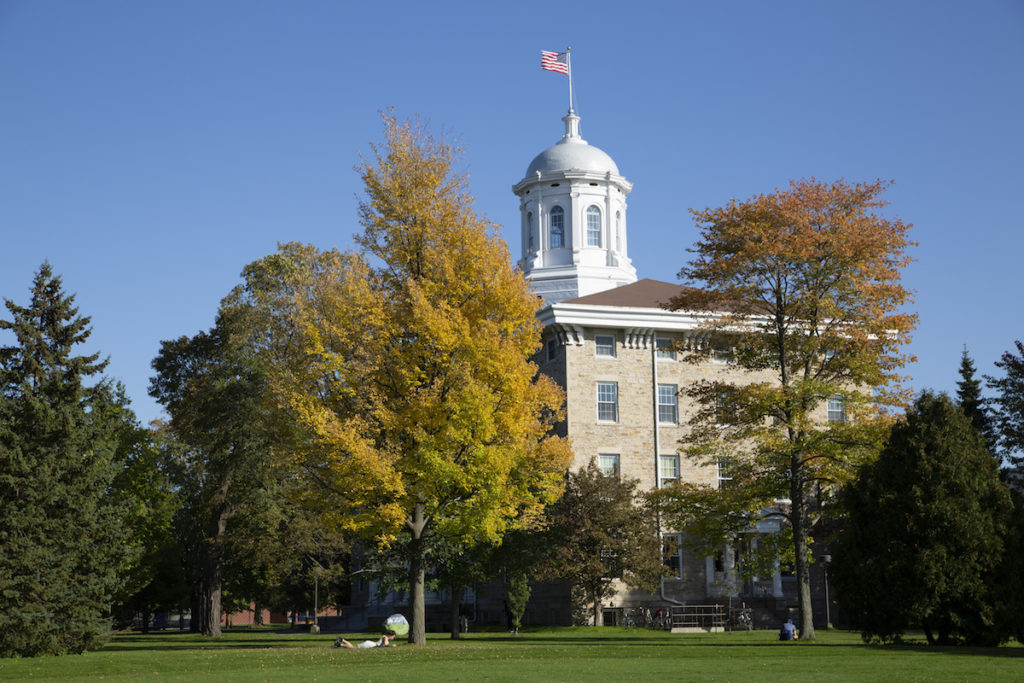
Main Hall, Lawrence University
Trend No. 1: Rising student debt changes the college conversation
The Lawrence reality: A commitment seven years ago to the Full Speed to Full Need initiative has student debt going down for Lawrence students.
Rising student debt has dominated discussions of higher education over the past decade, the last five years in particular. The burden on young college graduates, the number who are defaulting on loans, the economic repercussions due to an inability to save or to buy homes or make other substantial investments are points of debate in everything from politics to economic forecasting to family planning.
Student loan statistics, reported by Forbes in February 2020, before the pandemic hit and put student loan payments on pause, paint a daunting picture. Total student loan debt is at $1.56 trillion. The average student loan debt is $32,731. At private not-for-profit schools, that number is $32,300, 15% higher than in 2008.
Meanwhile, middle class wages across the country have remained stagnant since the Great Recession hit more than a dozen years ago, and the federal Perkins Loan Program, which provided low-interest loans for students who demonstrated exceptional financial need, has since been eliminated, adding to the financial pressures on many college-bound students.
The debt narrative has a more promising tone at Lawrence, though, where the answer has been to attack it head on with the help of the Full Speed to Full Need (FSFN) campaign. Jump-started by a $25 million gift from an anonymous donor and later increased to $30 million as part of an ambitious and successful matching challenge, the campaign has raised more than $91 million since 2014. Alumni have stepped up, recognizing the seriousness of the student debt crisis and the potential barrier it poses for enrollment, said Cal Husmann, vice president for alumni and development.
“It has resonated with this constituency unlike any other philanthropic priority,” he said.
Hundreds of Lawrence students have already been direct recipients of FSFN scholarships or have felt the impact of an increase in aid dollars available to students. The numbers will continue to grow.
In the process, the average debt for Lawrence graduates is going down—opposite the national trend—because the FSFN fund is allowing the university to provide additional scholarship aid, aimed at covering the gap between the full ticket price of enrollment and a student’s demonstrated ability to pay, meaning students are taking out fewer loans to cover that gap. In particular, there is less need to rely on burdensome private loans or to be overextended with multiple work-study expectations. It is leveling the playing field for families with limited resources.
The average student debt for Lawrence graduates has dropped to $29,118, its lowest mark in 10 years. It hit a high mark of $34,573 in 2015–16 and has dropped steadily each year since. The percentage of Lawrence’s students graduating with debt dropped to 56% in 2019–20, well below the 75% of a decade earlier.
About 70% of Lawrence’s students receive some level of need-based aid.
“We continue to offer competitive and generous merit-based scholarships and, at the same time, meet a high percentage of need for more students,” Director of Financial Aid Ryan Gebler ’02 said.
Over the past seven years, the percentage of first-year Lawrence students who had a demonstrated financial gap—the difference between financial aid and an individual student’s financial need—dropped more than 30%, from 70.9% to 38.69%. The scholarships have pushed the average gap down by $2,500, a 42% decrease, from $6,000 in 2014 to $3,500 in 2019–20.
The benefits also can be seen in academic performance as fewer students are having to deal with the added financial angst. The average GPA of FSFN recipients increased by .27 from 2016–17 to 2019–20.
Of the FSFN scholarships that have been awarded to date, 61% of the recipients have been students of color and 42% have been first-generation college students.
“I was a first-generation college student myself,” Husmann said. “I benefited from scholarships and took out loans. That’s one of the reasons I think Full Speed to Full Need as a core value of the college resonates with me. It’s just really exciting for me to see how it’s making such a positive impact on our students.”
The investments in FSFN are bolstering and providing momentum for other efforts to improve equity of experience at Lawrence. For example, financial aid, bolstered by FSFN and Be the Light!, now travels with a student who opts to study abroad, a change that has led to an increase in the number of students going to the London Centre and other off-campus destinations. In 2019–20, before the pandemic temporarily shut down in-person programs, Lawrence had about 150 students studying abroad, up from 89 the year before. Demographics from 2019–20 show a growing number of those students are first-generation college students, Pell Grant recipients, and domestic students of color.
Funding for experiential learning also has seen a dramatic uptick, courtesy of the Be the Light! Campaign. In summer 2020, 90 student internships and self-directed research projects were financially supported through the Experiential Learning Funds (ELF) program, more than double previous years, coordinator Emily Bowles said. The funds can help defray transportation costs, provide needed resources, or cover living expenses. It’s an effort to keep finances from preventing access to quality learning and career-building opportunities.
A new fund in the ELF program, the Equal Opportunity Fund for Career Exploration and Development, was launched last year to support BIPOC and first-generation students in new ways.
It’s all part of an investment in equity that has FSFN at its core.
Caitlin Zuehlke ’15, who worked in New York as a financial advisor for Merrill Lynch Private Wealth Management, said the growing student debt burden is hanging over every conversation about higher education these days, and to have Lawrence showing leadership in making real change is a point of pride for alumni.
“I’m excited that Lawrence is at the forefront of what I hope is a trend of universities helping to close that gap to make education more affordable to everybody,” Zuehlke said.
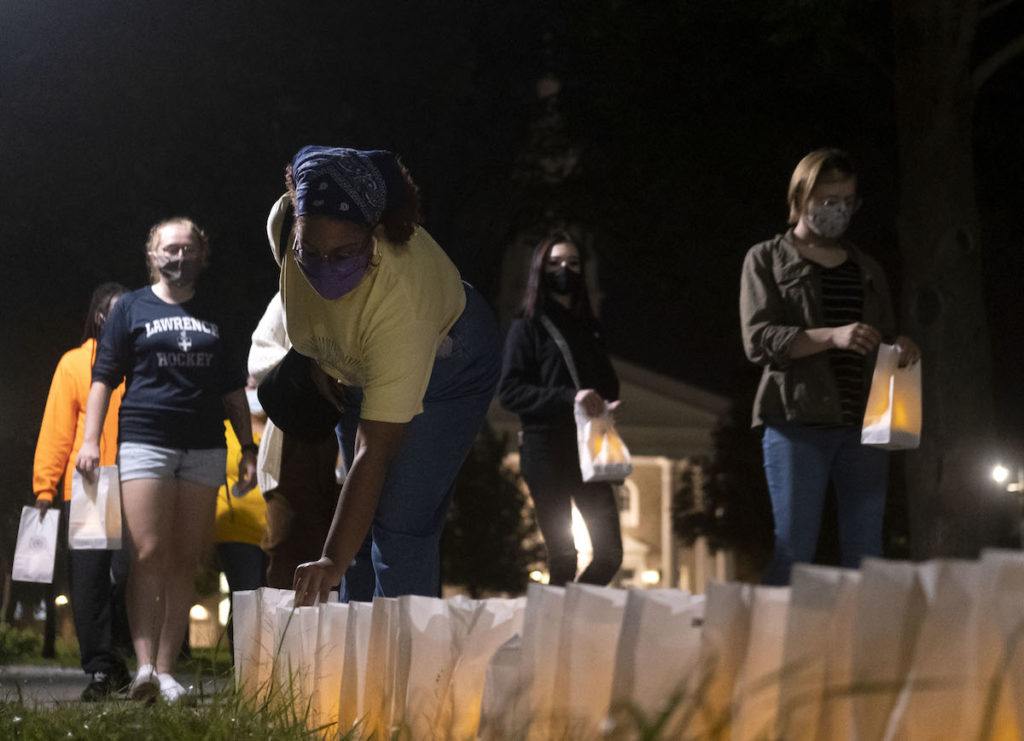
Be the Light!: A Reimagined President’s Handshake welcomed first-year students to campus in the fall.
Trend No. 2: Financial strain leads to growing number of closures, mergers
The Lawrence reality: A growing endowment and tightening efficiencies in the operating budget have the university in a position of strength.
The numbers are daunting, and they speak to the reality of the financial crisis that has its grip on higher education.
From 2016 through the end of the 2018–19 academic year, 163 colleges or universities in the United States closed or merged, according to the Chronicle of Higher Education. Of those, 55 were private not-for-profit schools—41 closed, 14 were consolidated through mergers. (Lawrence itself is the product of consolidation with the merger of Lawrence and Milwaukee-Downer Colleges in 1964.)
Even before the pandemic put a more intense squeeze on operating budgets, this trend was poised to accelerate. Private colleges with modest endowments and a heavy dependency on tuition income to pay the bills are running into turbulence as the student debt crisis alters the conversation for prospective students and the number of high school graduates begins a decline that’s expected to hit hard in five years.
As the economic chaos of the Great Recession exploded in 2008, family planning changed dramatically. Fewer people chose to have children, a trend that has continued. Do the math and you will see that those babies born in 2008 will be graduating from high school in 2026. Fewer graduates mean fewer college-bound students.
From 2026 to 2031, the number of high school graduates will decline 9%, putting new pressures on admissions offices and adding to the potential calamity for any college or university that hasn’t adequately girded itself for a changing marketplace.
Forbes’ College Financial Grades ranking, using data from the federal government’s National Center for Education Statistics database, was released in late November 2019. It didn’t paint a pretty picture for many colleges, and this was before the pandemic hit. It measured the financial health of 993 private not-for-profit institutions, looking at “balance sheet strength and operational soundness.” Of the schools graded, 675 earned grades of C or D, up from 434 in 2013.
Lawrence earned a robust B+, putting it in company with DePauw University, Middlebury College, Oberlin College, and Smith College, among others. Only 74 schools across the country were ranked as more economically sound than Lawrence.
Lawrence’s overall endowment has grown by more than 75% since Burstein’s inauguration in 2013, jumping from about $230 million to about $414 million over the past eight years. Much of the growth comes from increased philanthropy, led by the Be the Light! Campaign, but it also has been boosted by good stewardship on the investment front and an increased commitment to fiscal responsibility.
The Be the Light! Campaign raised $232.6 million, which Burstein announced in February at a virtual We Are the Light! event that officially brought the seven-year campaign to a close. Of that total, about $100 million has already been added to the endowment. Combined with trimming more than $5 million from Lawrence’s operating budget through recent cost savings and adjustments focused on administrative efficiency, the campaign positions the school to grow stronger while facing the difficult financial environment ahead.
The higher ed marketplace is reflective of what Jenna Stone ’00, Lawrence’s associate vice president of finance, calls the industry’s economic reality and Lawrence’s well-positioned place within it. Lawrence isn’t in the financial company of a handful of ultra-wealthy schools, mostly on the coasts, with overflowing endowments. And it happily isn’t in the company of those schools with limited endowments that are making headlines because of their various financial woes.
“Lawrence is in an increasingly tiny middle class,” Stone said, stable enough to be positioned for good health but not so flush with cash that it doesn’t have to work hard to keep things moving in a positive direction.
It’s a familiar story, not specific to higher education.
“It’s the same growing wealth inequality that we see among households in America, where the bottom 50% has largely stagnated for the last 15 years while the top 1% has gotten far wealthier,” Stone said. “We’re seeing that same kind of growing inequality of wealth among colleges and universities, where the wealthiest schools are getting increasingly wealthier. They’re getting more mega-gifts, their endowments are getting bigger and bigger and bigger.
“On the other end, you have generally small, not well-resourced liberal arts colleges, entirely dependent on tuition revenues that did not cover their fixed operating costs, hoping for years that things are going to get better. It becomes a vicious cycle, a downward spiral financially. These are a lot of the colleges that you see closing, merging or being acquired, or they are in the news because their debt or bond rating has been downgraded.”
Lawrence, Stone said, is in a much healthier place. The Full Speed to Full Need scholarship initiative has helped to solidify the school’s position as a financially stable institution with a progressive approach to meeting academically qualified students where they’re at and setting them up for success after college.
Mary Alma Noonan, Lawrence’s new vice president of finance and administration, said the key has been philanthropy.
“In addition to the scholarships, we have been really successful in getting endowment support for capital renewal of the campus, for academic enrichment through funded professorships, for programming that will help our students be successful, and for life after Lawrence,” she said. “We are eternally grateful to the thousands of donors who have supported these efforts year in and year out.”
In September 2019, Lawrence placed No. 26 on Forbes’ 2019 edition of the Grateful Graduates Index, a measurement of alumni giving at private, not-for-profit colleges. Lawrence was the only Wisconsin school to place in the top 70. It speaks to the strong relationship between the school and its alumni, a key to building and maintaining an enduring endowmentWhen the waters get rough, a healthy endowment remains a university’s stabilizing force. In good times, a strong endowment provides resources for continual investment and renewal. In leaner times, it provides the runway needed to make thoughtful, strategic course corrections in the long-term interests of the institution. It is the key to any private college’s future sustainability, and the importance of Lawrence’s endowment growth over the past seven years cannot be overstated.
Endowments, of course, are not static. They are invested with the expectation that they will grow.
Lawrence’s endowment has seen a five-year average return on investment of 6.6%, which is above the 5% national average for institutions with similarly sized endowments, according to an annual study recently released by the National Association of College and University Business Officers. Lawrence’s 10-year average return, meanwhile, checks in at 8.5%, above the 7.6% national average.
The Board of Trustees’ Investment Committee manages the Lawrence endowment.
The university strives for intergenerational equity in the investments, a philosophy aimed at managing the investments with a long-term eye, reasonably limiting risk, while spending prudently so as not to sacrifice future generations for the benefit of this generation.
“Our goal is to steward the endowment in a way that it will serve Lawrentians 50 years from now as faithfully and as well as it serves the Lawrentians of today,” Stone said.
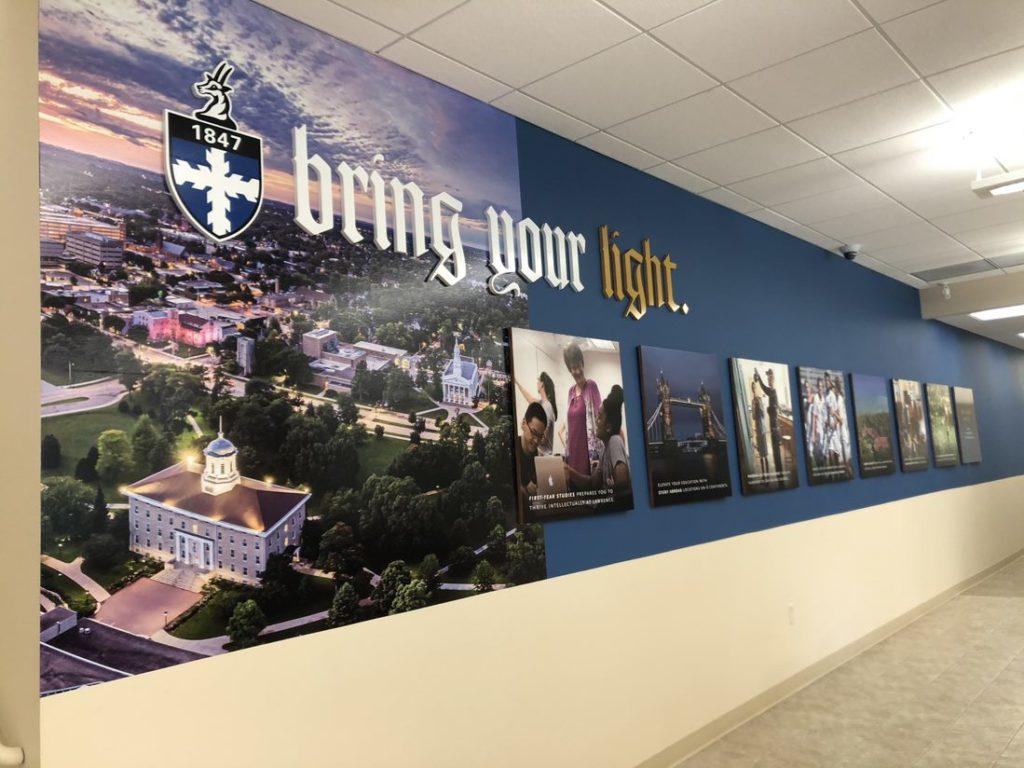
Admissions wall in Chapman Hall.
Trend No. 3: Changing demographics are reshaping the admissions landscape
The Lawrence reality: The university’s admissions reach has long been transitioning from regional to national. The foresight to do so is paying dividends now.
The admissions landscape has been altered dramatically, and the storm clouds keep coming: The rules of when and how schools can recruit students have changed; the Varsity Blues admissions scandal that involved numerous well-known schools, mostly on the east and west coasts, exposed a flawed process; and admissions offices across the country are staring down the approaching steep decline in the number of available college applicants. Add to that a global pandemic that halted travel, severely limited campus visits, and rewrote on the fly the entire process of student recruitment.
Lawrence, with an enrollment of about 1,425, draws students from across the United States—and around the globe—in far greater numbers than in decades past. New investments in national and international recruitment started years ago, giving Lawrence a strong base to build on. That’s no small thing as the Admissions team looks toward significant challenges on the horizon.
Ken Anselment, vice president for enrollment and communication, said geographic flexibility is among the reasons Lawrence is well-positioned to navigate this ever-changing environment. But that’s not saying it’s going to be easy.
Consider that in 1999, more than 60% of Lawrence’s students came from the regional market of Wisconsin, Illinois, and Minnesota. If you include the rest of the Midwest, that number was closer to 75%. That’s a much different story than today, with classes coming in with a wider geographic footprint. About 50% of Lawrentians now hail from the Midwest, with Wisconsin, Illinois, and Minnesota comprising about 40% of the students.
The number of students coming from southern and western states or international locations, meanwhile, has more than doubled.
That doesn’t mean Lawrence has less interest in students from the Midwest. Rather, it’s been a strategic shift to reflect changing demographics, Anselment said.
“What you’re seeing is a shift where high school seniors in the country live, and the benefits of Lawrence’s national and international reach and reputation,” he said.
While the number of high school seniors across the country has generally been growing this millennium, from 2.85 million in 2001 to 3.77 million in 2019, that growth has not been evenly distributed. The western and southern parts of the United States have been growing while the rates of growth in northeastern and midwestern states have been flat to gradually declining, Anselment said. That’s all a precursor to the dramatic drop in numbers that is coming in five years, when those babies of the Great Recession begin hitting adulthood.
Lawrence has been preparing for that, and its admissions work has been purposeful in positioning the school to adapt to the changing market.
“This is the result of an institutional strategy we developed decades ago to raise Lawrence’s global visibility and, along with that, our enrollment of a globally diverse student population, which provides immense educational benefits in preparing Lawrentians to thrive in an increasingly interdependent global economy,” Anselment said.
The strategy, already paying dividends, allows Lawrence to approach the coming decline in college-age students from a position of strength. Not only does Lawrence have a great story to tell, it also has now firmly established itself in key markets.
The number of high school seniors in the U.S. is expected to peak at 3.93 million in 2025. From there, the decline will be sharp and prolonged.
“There will be far fewer of them, which means that an already competitive market for college students will become even more intense as we see a 10% drop in students from 2026 to 2037,” Anselment said.
That looks to be the new normal, with economics and lifestyle choices often cited for reasons that more young adults are opting not to have children. Birth rates fell to a 33-year low in 2019, according to the Centers for Disease Control and Prevention.
At the same time, the population of high school seniors is becoming more racially and ethnically diverse with each passing year. For Lawrence, that has increasingly become a point of admissions strength. From 2015 to 2020, the percentage of students of color at Lawrence has increased from 19% of the student body to 26%, said Kimberly Barrett, vice president for diversity and inclusion. The number of faculty of color also has grown over that five-year period, going from 13% of total faculty to 17%.
“Much work remains to be done,” Barrett said.
In addition to recruiting a student body and faculty that is more reflective of the nation’s demographics, Lawrence also is committed to better serving all members of its community. In the final years of his presidency, Burstein has committed the institution to ongoing antiracism work as both a strategic and moral priority.
Growing the campus’ diversity—racial and otherwise—has been an intentional part of Lawrence’s institutional commitment and bodes well for the challenges ahead, Anselment said.
“Much as the diversity of our academic and artistic offerings at Lawrence cultivate broad and deep intellectual competence, a diverse living and learning community at Lawrence reflects a global society,” he said. Anselment emphasizes that this drive to become a more diverse and inclusive university is not just for the educational benefit it offers. “This is a key component of our institutional values, one of which is to foster a diverse and welcoming learning community that embraces all members, including those marginalized by their identities.”
Anselment pointed to Lawrence’s strong partnerships with community-based organizations such as the Posse Foundation in New York, Achieve in San Francisco, Chicago Scholars, College Horizons, and the Davis New Mexico Scholars program, all of which work with students from historically underrepresented communities.
“We have surrounded our students with faculty, staff, spaces, and services to help create the kind of welcoming, inclusive, and equity-minded environment where they can thrive,” Anselment said.
The pandemic, of course, has altered everyone’s well-laid plans. For Lawrence, the commitment to geographic and cultural diversity continues even while the business of admissions is being rewired. The pandemic lockdown that came last March forced admissions offices across the country to find new, digital avenues for connecting to prospective students, from more elaborate online campus tours to video chats to digital college fairs.
None of it is perfect. But it’s not going away, even when the pandemic subsides. At least not all of it. New skills have been learned. New expectations have been built. New financial pressures are in play. Admissions offices will need to make adjustments, find the sweet spot between new-found efficiencies and time-honored traditions. What will become of standardized testing as more schools go test-optional, something Lawrence blazed a trail with more than 15 years ago? Will travel to college fairs and other face-to-face recruiting return to previous levels? Will students demand it? Will they ask for something different?
It’s all part of the daily conversation for Anselment and his colleagues.
“How can we use this time of upheaval to advance our cause?” he said. “Consider this a dress rehearsal for the markets so many of us will face in 2026.”
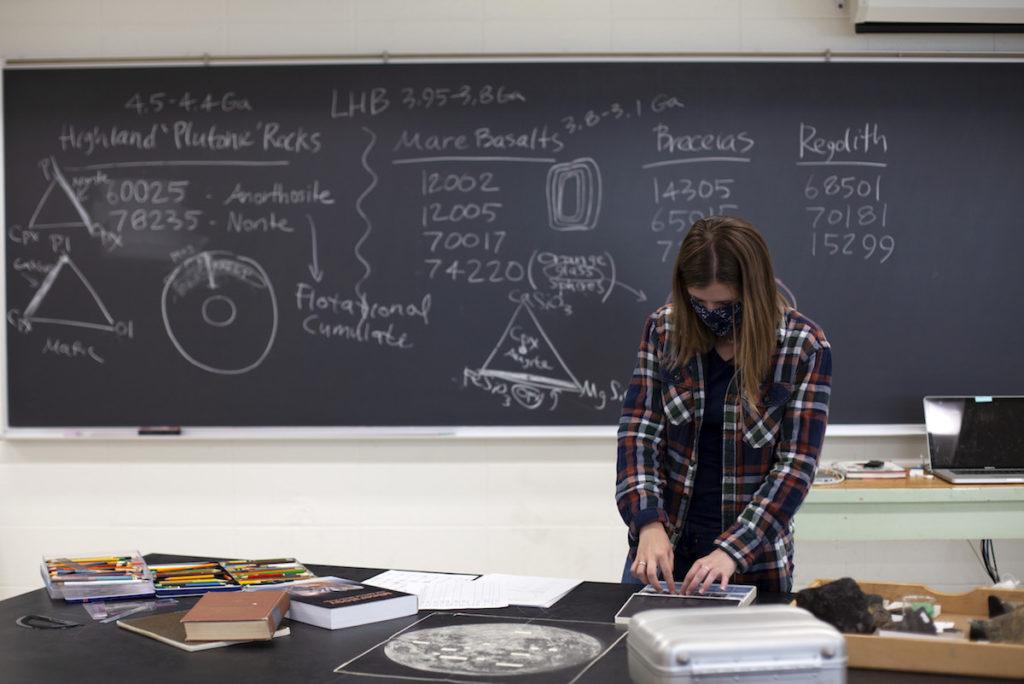
Students studying in the geosciences now have an option to major in environmental science.
Trend No. 4: The rolling back of liberal arts offerings, rise of online-only education
The Lawrence reality: The university is staying committed to its liberal arts principles while adding or strengthening key academic programs and embracing a holistic, personal approach to educating its students.
The growth in jobs tied to coding, data science, and other STEM-related fields in recent years has put liberal arts programming as traditionally conceived in the crosshairs of those who believe a college education need be nothing more than job prep.
Cuts, or proposed cuts, to liberal arts offerings at, among others, the University of Akron, McDaniel College, and Ithaca College have drawn national attention. The University of Wisconsin-Stevens Point, located 60 miles west of Appleton, was in the spotlight in 2018 when it floated a plan to eliminate 13 majors, mostly in the humanities, as part of campus-wide budget cuts. It eventually reversed course.
Online-only programming has pushed the same argument. Get a degree. Get a job. The end.
The pandemic, meanwhile, pushed colleges across the board, including Lawrence, to quickly move all or most of their classes to distance learning. That has reshaped conversations going forward about digital classrooms. It brought new skills and new comfort with distance learning technology, and as post-pandemic classes return to in-person interaction, some of that new-found digital know-how will surely be in play. But video classrooms also spotlighted a deep desire for face-to-face learning. A Stanford University study released in February reported that “Zoom fatigue” is a real thing that is taking a toll on our physical and mental well-being.
The past year of seclusion and isolation also has reminded us of the joys of an education that spans the disciplines. Even before the pandemic, there was a growing push-back in defense of a liberal arts education, one that not only leads students to successful careers but also preps them with the skills to navigate a well-lived life. Yes, the marketplace is asking for more computer science majors, but when those coders and data scientists come out of a liberal arts school, they come equipped with the ability to lead, to collaborate, to think critically, and to grow into well-rounded contributors in and out of their areas of study.
In a report released in January 2020, the Georgetown University Center on Education and the Workforce affirmed what Lawrentians already know—a liberal arts education is a worthwhile investment. The report, a rebuke of the short-sighted approach that suggests colleges should be doing nothing more than prep work for that first job, stated that the return on investment (ROI) for liberal arts colleges continues to grow at greater rates than other colleges over the course of a lifetime.
The study “finds that the median ROI of liberal arts colleges is nearly $200,000 higher than the median for all colleges. Further, the 40-year median ROI of liberal arts institutions ($918,000) is on par with those of four-year engineering and technology-related schools ($917,000) and four-year business and management schools ($913,000).”
Lawrence has continued to embrace the benefits of its liberal arts offerings while expanding programs to address areas of opportunity—among them a new major in computer science, a new minor in data science, enhanced offerings in neuroscience, a new degree program in music, expanded opportunities in creative writing, and the latest, a new major in environmental science. More are in the pipeline.
In 2021, The Princeton Review once again included Lawrence as one of 200 schools on its recommended list of Best Value Schools, based on return on investment. It considered more than 40 data points covering academics, affordability, and career preparation in making its recommendations.
“The liberal arts philosophy at Lawrence is as strong as ever,” said Provost and Dean of Faculty Catherine Gunther Kodat. “The widening mix of academic opportunities and a campus-wide effort to educate the whole student is the 21st-century liberal arts formula to best prepare students for a rapidly changing world. It’s what sets liberal arts institutions such as Lawrence apart, and why proponents of the liberal arts should continue to push back emphatically when critics question their value in today’s marketplace.”
“There’s an awareness of the full range of opportunities,” Kodat said of liberal arts schools. “To think about a career not just in terms of a job, but also the kind of person you want to be—the kind of artist or thinker or philanthropist, imagining yourself being in a place at some point in the future where you could do good in the world and envisioning how that would happen. Liberal arts colleges offer a course of study that is all about enabling that exploration. It’s a wonderful combination of open-ended exploration and directed study.”
A 2019 report from the Andrew W. Mellon Foundation rallied to the defense of the liberal arts philosophy, but with the caveat that colleges and universities must continue to adapt to a changing world. The report, authored by Catharine B. Hill and Elizabeth Davidson Pisacreta, both economists with Ithaka S+R, called the perception that liberal arts colleges are not graduating students in math and science fields a myth. High-level education in STEM fields is alive and well.
Lawrence has long fit the bill. It has sought-after programs in biology, biochemistry, chemistry, physics, and mathematics, to name a few, and has now added depth and range in areas of cognitive neuroscience, computer science, and data science. A $1 million grant from the Howard Hughes Medical Institute to implement its Inclusive Excellence Initiative is helping to catalyze efforts to engage science students of all backgrounds and identities.
The recent additions or enhancements to those key academic programs have added strength to an already robust curriculum. Computer science, long a part of the mathematics offerings, can now be pursued as a major on its own. And data science, where demand in the marketplace has grown mightily over the past few years, was introduced as a minor in the 2020–21 academic year, strengthened by the recent additions of two talented faculty members—Andrew Sage and Abhishek Chakraborty, both assistant professors of statistics—with deep interest in studying large and often complex data sets. Meanwhile, the Dennis and Charlot Nelson Singleton Professorship in Cognitive Neuroscience has been added to serve as an important bridge between offerings in cognitive science, cognitive psychology, and neuroscience.
Also, the J. Thomas Hurvis Professorship of Organizational Psychology and Collaboration is a new position that has applications across all departments on campus as it teaches business and management science through a liberal arts lens. A new creative writing track was introduced to add options for English majors. And the new environmental science major will add new paths for students seeking a more science-focused curriculum tied to environmental studies and the climate crisis. New programs including an international relations major and health and society minor have also just been added to the curriculum.
In the Conservatory of Music, the path in was widened with the introduction of the Bachelor of Musical Arts (B.M.A.) degree, which offers a different auditioning landscape and puts a greater focus on improvisational performance and other music-related possibilities. Other changes in degrees for music majors are being explored, part of an attempt to encourage a greater breadth of musical exploration.
Those changes don’t soften the liberal arts approach; they strengthen it, Kodat said. It’s important to stay true to liberal arts principles while also remaining nimble enough to make strategic adjustments as the world changes. That’s particularly critical in some of the science and math fields, where Lawrence has long excelled and where pragmatic training is part of the drill.
Mixing those skills with the wider liberal arts education puts Lawrence students in position to not only excel in their first jobs out of school but to confidently transition to the job after that and the job after that as career demands and interests change.
“We are at a place right now as a world—in terms of technology, in terms of where the economy is going—where we actually don’t know what the big careers are going to be even five years from now,” Kodat said. “What I think employers are looking for are graduates who are creative thinkers, problem-solvers, can work in a group, understand what community is. That’s the kind of experience that only a liberal arts education can give you.”
On the Student Life side, meanwhile, the changes are already being implemented to strengthen the liberal arts experience, with more to come. The close, one-on-one relationships that have been a hallmark of a Lawrence education inside the classroom are extending outside the classroom.
Vice President for Student Life Christopher D. Card said Lawrence is adjusting its co-curricular experience to meet the needs of today’s students, adopting a holistic approach to Student Life that is strengthening the liberal arts experience.
The pandemic brought massive, if temporary, changes to life on campus, with mask-wearing and physical distancing being built into the safety protocols that came with the reopening of campus in the fall. As we look ahead with hopefulness to something resembling normalcy, Card said the commitment to a holistic approach to the student journey remains. That includes the ongoing transformation of career preparation, wellness services, mental health support, spiritual life, and academic advising, as well as a new emphasis on mentoring across campus.
“I think folks come here because they expect a particular relationship to emerge, certainly with solid academics and rigor,” Card said. “They want to be challenged. They want to know they are getting a first-rate education, but also a first-rate experience outside of the classroom in terms of their own personal growth and development.”
Wellness on campus, for example, was already being reimagined before the pandemic arrived.
“Right now, we have three entities under the proverbial umbrella of wellness—physical health, with the director of health and the nurses in that space; the counseling center, which focuses primarily on the emotional and mental well-being; and then recreation,” Card said. “That is an umbrella that is expanding more and more as we get into everything from nutrition to activities to exercise to diet to mindfulness, and so on.”
That includes being responsive to mental and emotional health concerns of students. That has been a priority before and during the pandemic and will continue to be when the pandemic is in the rear-view mirror.
“Mental health is going to be on our agenda for the foreseeable future,” Card said. “We want this to be a place where we minimize any stigma so we can eliminate any reasons for a student not to come in and say, ‘I need help.’ I think the critical thing families and prospective students need to understand is we’re supportive, this is a place that supports and affirms.”
That supportive and inclusive approach also has played out in tending to students’ spiritual or religious interests. Linda Morgan-Clement, the inaugural Julie Esch Hurvis Dean of Spiritual and Religious Life, and Terra Winston, associate dean of spiritual and religious life, now staff the Esch Hurvis Center for Spiritual and Religious Life. They played key roles in guiding students who had to go through quarantine or isolation in Kohler Hall during the pandemic.
Tending to spiritual needs has had an increased focus on campus since Morgan-Clement came on board in 2016, an endowed position that came out of the Be the Light! campaign. The increased programming at Esch Hurvis Center then led to the creation of the associate dean of spiritual life position in 2018.
Also, a $1.5 million investment courtesy of Be the Light! has relocated and modernized the Center for Academic Success on the second floor of the Seeley G. Mudd Library. The new space offers more visible and efficient academic support for students, focused on everything from tutoring to accessibility services to academic counseling.
That’s all part of the approach of tending to the whole student, Card said.
Card said it’s increasingly important to meet the needs of students as they progress through Lawrence, from arriving as first-years to heading into life after Lawrence four years later. The mission of Student Life, he said, is to help guide that journey in positive, affirming ways.
“There’s a certain pattern and rhythm that goes along with student life,” he said. “I think what we’re trying to do now is better align how we train in that space.”
With that has come new investments in the Career Center, courtesy of $5 million from the Be the Light! campaign. The past two years has seen the launch of Career Communities, an online resource guide divided into groupings of related fields or potential career interests, and Viking Connect, an online platform to better connect students with alumni employed in fields of interest. And Mike O’Connor was hired as the first Riaz Waraich Dean for the Career Center & Center for Community Engagement and Social Change. That’s all brought new engagement between students and alumni and has resulted in an uptick in experiential learning opportunities.
“We’ve started engaging students earlier about careers,” Card said. “In this first full year of rolling out Career Communities, we’ve engaged more than 80% of the first-year class already. That’s space we knew we needed to get better at. We’re already seeing results.”
Part of that is encouraging and nurturing mentorship on campus. Lawrence has been blessed with a long tradition of positive mentoring relationships between faculty and students. That comes in part because of Lawrence’s 8-to-1 student-to-faculty ratio. The work in the Career Center, including via Viking Connect, is now clearing the path for similar relationships between students and alumni.
“A very good friend of the university, an alum, frequently asks me and asks students, ‘Who is your person?’, and by that he means, who do you count among your supporters here?” Card said. “Who is giving you good advice? Who is holding you to account? Who is one of the angels granting safe passage? I think that’s what we’re trying to do, to figure out; how do we install a whole bunch of angels who grant safe passage along the way?
“My hope is that a student will be able to come to Lawrence and find they can find strong and willing mentors in the classroom, that they’re in the halls, that they’re in organizations they become members of, that they’re on the athletic fields along with them. And when they look around, they realize that this is a place that offers more support than they probably imagined.”
That, Card said, is part of that synergy between the academic opportunities of a liberal arts campus and the student experience.
“I think what makes students sort of feel a better sense of place and purpose is when we infuse the academic journey with a focus on affinity, a deepening sense of belonging, building connections to those around you, and really forming relationships that are truly supportive,” Card said. “It’s going to be challenging. I’m not one who thinks college should be easy. I don’t think anyone ever promised that. I tell parents all the time, ‘The critical thing is, when things get tough, will your child find that there is ample support to navigate that?’”
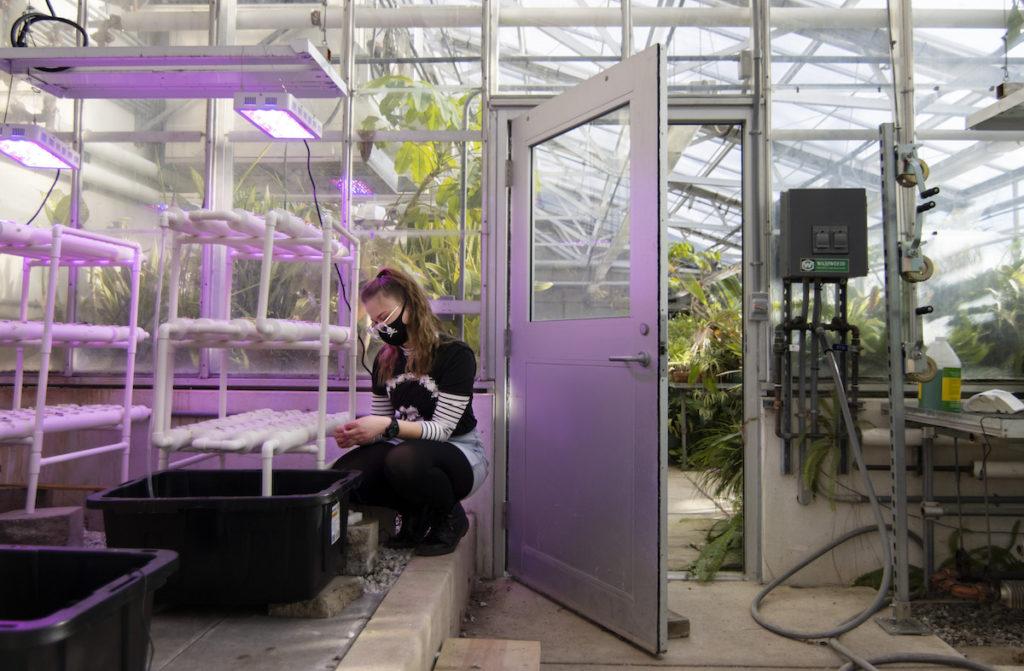
Research and other experiential learning opportunities have grown in recent years, including here in the Briggs Hall greenhouse.
Eye on the future: Prepared to thrive
The coming months and years will not be easy. Lawrentians will be challenged time and again to stay committed to the things that have made Lawrence strong for the past 174 years.
But, thanks to Burstein’s leadership, the support of the alumni community, and talented and committed faculty and staff, the pieces are in place for Lawrence to thrive amid those challenges. The philanthropic support via the Be the Light! Campaign, the strategic growth of key academic offerings, and the university’s increasingly national and global reach has Lawrence prepared for these difficult waters.
Through it all, Card said, the focus will remain on the students—those who are here today and those who will be coming in generations ahead.
“We are catering to folks who love learning, who we want to prepare for life,” he said. “This is not just about these four years and the year or two after. This is a place that will embed you with some serious skills to navigate life.
“If you talk to alums, that’s what they’ll tell you. If you talk with faculty, that’s the approach they are taking. And I think, truly, when you get into the heart of what the student is coming here for, it’s not just about simply getting a college degree; it’s about getting a life degree.”
Continuing to make that happen will take an ongoing commitment from all of the Lawrence community, Burstein said. Lawrentians have already shown a willingness to rise to the occasion.
“Our efforts to enhance the education we offer and to make it affordable to all families has resonated in the marketplace,” Burstein said. “It’s allowed Lawrence to thrive while other institutions have struggled.”
